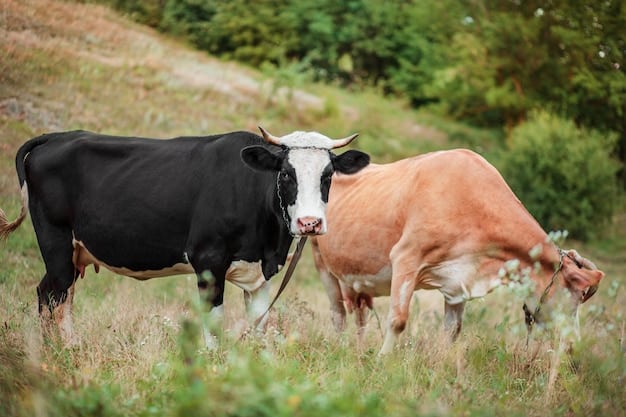
Feeding co-products in beef cattle rations is a tradition that dates back to the early days of beef finishing. In the 1940s, California feeders were using co-products from the vegetable processing industry, including artichoke hearts, grape pomace, apple pomace, cull carrots, and citrus pulp. In the midwest, feedlots used soybean meal and hulls from nearby soy processing plants. And in the Northwestern states, wet potato waste from nearby potato processing plants was also used.
Contents
Cost of beef cattle rations
To determine the cost of beef cattle rations, you need to know the feed prices and what feed is available on the market. If prices are high, you may want to reduce corn consumption in your rations or add more roughage. To save money, it might make sense to experiment with different feedstuffs and compare the performance of your animals.
Good-quality hay contains 10% protein and 58% TDN, and costs about $110 per ton. This means that feeding two pounds of supplement per head of cattle costs $1.70. Alternatively, feed producers should consider feeding a fair-quality hay, which contains 8% protein and costs about $90 per ton. This means that feeding a 100-head cowherd will cost approximately $220 per head of cattle, or $21,972 per year.
Alternative fiber sources
While protein and energy are often the focus of beef cattle nutritional programs, the content of fiber is essential to their overall health and productivity. Cattle grow at different rates depending on the type of feed they are given, and the type of fiber can make a difference to growth and overall carcass attributes. The presence of fiber in cattle rations is also associated with better rumen health.
Typically, cattle should consume 0.5 percent of their body weight in forage daily. This means that a 1400-pound cow would need about seven pounds of hay or 22 pounds of corn silage to achieve this goal. However, if feed cost is not an issue, there are other sources of fibre for beef cattle that can help beef producers maintain healthy herds.
Vitamin A requirements
Vitamin A is one of the most important nutrients in the diets of beef cattle. It is essential to the growth and development of these animals, and it also plays a crucial role in the function of their nervous system and bone development. In beef cattle, a deficiency can cause a number of symptoms. These include night blindness, poor appetite, dull eyes, and slowed growth. It may also lead to pneumonia or diarrhea in young animals. Later signs of vitamin A deficiency include lameness of the legs and knees, excessive watering of the eyes, and convulsions.
Cows store approximately 90 percent of their vitamin A in their liver. The remainder is stored in their fat. This is because the liver cannot efficiently convert all the carotene in their diet into vitamin A. This is why fat contains more yellow color. Because cattle cannot convert all the carotene in their diets into vitamin A, these fats have a yellow color. Although the biological function of carotene is unknown, it is an important source of vitamin A in cattle.
Energy requirements
Beef cattle have unique energy requirements. These needs are determined by the overall energy required to maintain the animal’s metabolic processes and growth. Throughout the yearly production cycle, the energy requirements of beef cattle change. Energy needs for pregnancy, lactation, and post-weaning are higher than the rest of the time.
Energy requirements vary from cattle to cattle, but generally, a cow needs more than one percent of their TDN to maintain its body. Energy is also required to produce milk and to maintain body weight after calving. In addition, larger cattle require more TDN per day than smaller ones. A cow must also be fed more energy than a lighter cow.
The energy requirement of beef cattle can be calculated by dividing the total energy (ME) required for growth, maintenance, and lactation into a net energy (NE). Beef producers and beef nutritionists can manage the energy requirement of beef cattle by using simpler methods or by incorporating multiple systems into their rations. In this way, they can ensure that their herds are getting adequate energy for growth and maintenance.
Protein sources
Soya is a common source of protein in cattle feeds around the world. Soya meal contains 440 to 480 grams of crude protein per kilogram. It is a highly digestible source of protein that is ideally suited for use in feed compounders. In addition, it is a relatively inexpensive source and is readily available in many forms. Its inclusion rate in monogastric diets is generally between 30 and 40 percent. Soya meal is also a very good source of lysine.
A key driver of change in the agri-food industry is the desire to increase production efficiency and competitiveness. As such, it is imperative to benchmark performance and eliminate unnecessary costs. This is particularly important when it comes to protein sources and diet formulation. The value of different protein sources in rations is often determined by least cost programming. In addition, technological advances are continually advancing, which can lead to significant impacts in livestock production. This means that it is crucial to understand how these advances can be beneficial to everyone involved in livestock production.



